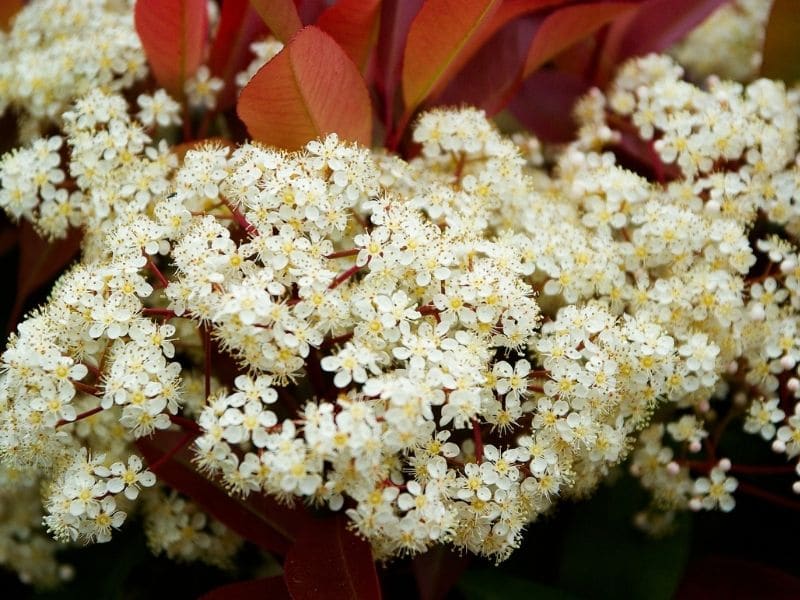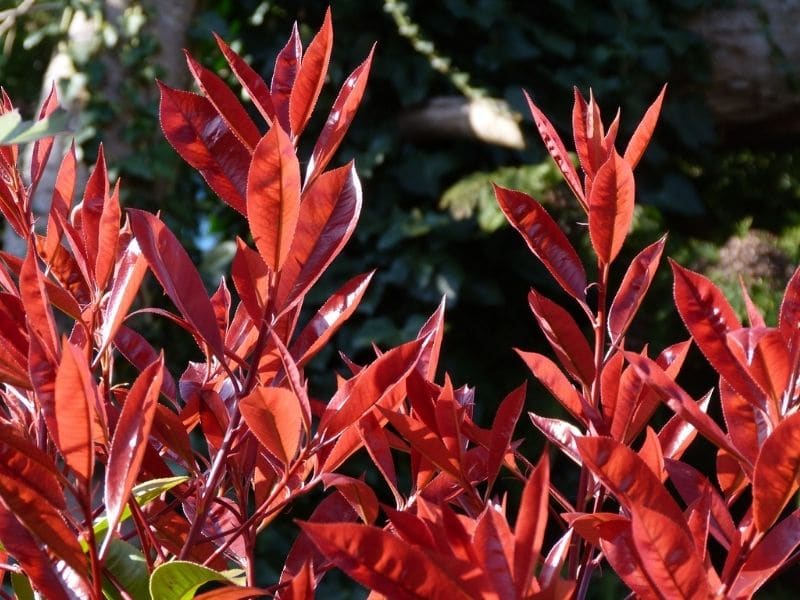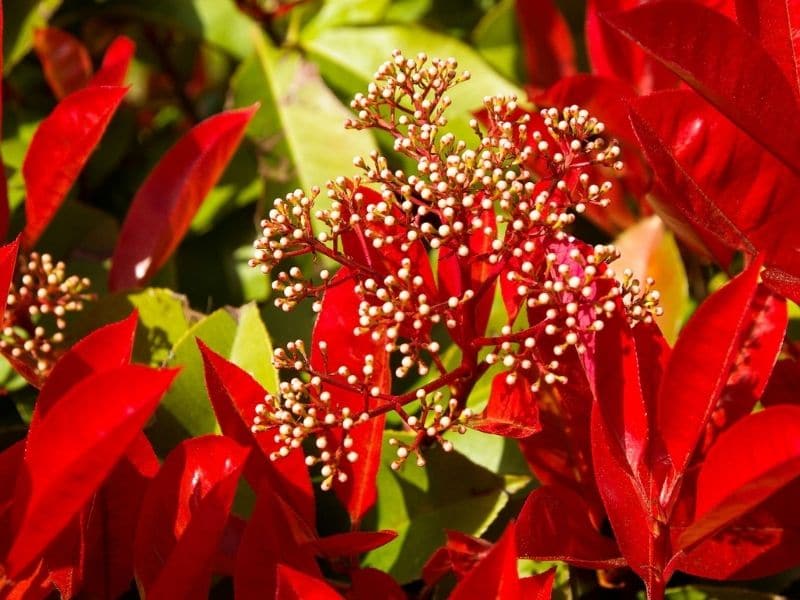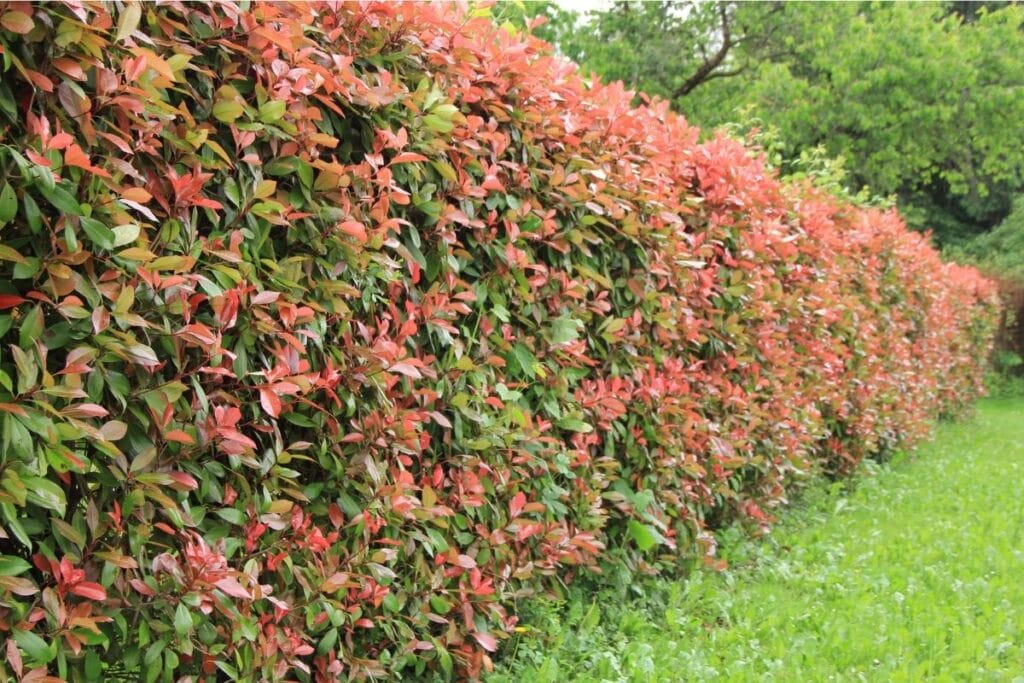Photinia plant is a very popular ornamental evergreen shrub that is frequently found in gardens throughout the Southern United States. This plant has both attractive foliage and an impressive floral display.
Unfortunately, this isn’t always the easiest plant to keep in good health and should be considered carefully before being selected for your next gardening project.
What Is A Photinia?
Photinia, pronounced foe-TIN- nee-uh, is an evergreen shrub of the Rosaceae family. The most popular Photinia for the garden is the Red tip or Fraser photinia, Photinia x fraseri which is a hybrid of two Asian species.
These parent species are the Japanese photinia, P. glabra, and the Chinese photinia, p. serratifolia.
P. glabra occurs in Japan, China, Myanmar, and Thailand where it may be found growing in mixed forests and on slopes at altitudes of 1640 to 2620 ft (500 to 800 m) above sea level. P. serratifolia, which is the larger species, occurs in a variety of habitats from sea level to 8200 ft (2500 m) in the countries of China, India, Indonesia, Japan, and the Philippines. (1)
Red tip photinias generally reach a height of around10 to 15 ft (3 to 4.5 m) tall and 5 to 8 ft (1.5 to 2.4 m) wide with an oval, upright crown.
The attractive foliage consists of deep red new growth which transitions into a glossy deep green, alternately arranged leaves with serrate margins. These leaves, which take between a fortnight and a month to mature, measure 3 to 5 inches (7.5 to 12.5 cm) in length and are oval in shape.
Photinia Flowers

Photinias are very showy plants, producing a profusion of white to cream flowers in the spring and summer. Unfortunately, the white flowers of this plant have an odor that many find unpleasant and many gardeners prune their plants in order to prevent them from flowering.
That being said, in larger gardens, if planted in areas further away from the house, or in other landscaping applications such as parking lots, road islands, etc., this plant’s dazzling floral display is really quite impressive.
The small blossoms of Photinia shrubs, which have 5 petals and 5 sepals each, give way to small berries that start out white, turning red and ripening to black. These fruits, which are enjoyed by birds, may persist into the winter months.
Varieties and Species of Photinia Bush
P. glabra or the Japanese photinia is a smaller species, reaching a maximum of around 12 ft in height and is suitable for the garden, but may suffer from mildew and leaf spot under certain conditions.
The Chinese photinia, P. serratifolia grows much larger, achieving impressive heights of up to 30 ft (9 m). This is a hardier species but may still suffer from fireblight and mildew in humid conditions without enough sun.
Several varieties are available, including P. x fraseri ‘Pink Marble’ which has interesting green and white or green and pink variegated foliage. ‘Red Robin’ is the most popular variety and has bright red stems and coppery foliage.

How to Grow Red Tip Photinia Shrub
Being a hybrid, Red tip photinias will not grow true to type if grown from seed, and therefore growing from cuttings is recommended. Growing these plants from cuttings is fairly straightforward and can be achieved in the following manner.
Take your cuttings in late summer to early fall. Cut stems with a diameter of around 1/10 of an inch (2.5 mm) and 6 to 8 inches (15 to 20 cm) in length.
Avoid soft new growth for best results. Remove all but the top pair of leaves and insert the cuttings an inch or two into your growing medium.
Roots should develop within a month, but the plants should be kept in a cool area and the growing medium kept moist until the following spring when they can be planted out.
Red tip bushes require well drained soil with a neutral to acidic pH. These plants should be located in areas with good airflow to prevent disease.
These plants are fairly drought resistant and can be grown in dry to moist soils but should not be kept in saturated substrates. Take care to water the soil, rather than the leaves of your plant.
These plants do best in full sun to partial shade. They can be grown in deeper shade but may be prone to leafspot in these conditions.
Red tips shrub can be grown in USDA hardiness zones 7 to 9 and to UK zone 8 where they will grow at a moderate to fast rate, often producing 2 ft (60 cm) of new growth per year.

Care and Maintenance
Pruning
Red tips can be pruned throughout the growing season, and it is good practice to prune them in winter twice a year to open them up a little for improved airflow, especially in more humid environments.
If you clipped your ornamental shrub at the end of winter, you may have lost its flower buds, but don’t fret since they will regrow for the next spring.
Frequent pruning Photinia encourages the attractive red new growth and prevents flowering if the smell of the blossoms is a concern.
These Photinia plants will produce red new growth in the early spring and can be pruned throughout the summer and into the fall to encourage new red growth.
Take care, however, to not prune too late into the fall as new growth should be given a chance to mature and harden off before the first frosts.
Propagating
Propagating red tip photinia is a rewarding and surprisingly simple process. This versatile shrub can be grown from both seeds and cuttings, offering gardeners a choice in approach.
While seeds require patience and specific stratification techniques, propagation through semi-hardwood cuttings taken in midsummer is the most successful and commonly used method.
By selecting healthy stems, preparing the cuttings properly, and providing them with a warm and humid environment, you can successfully cultivate new red tip photinia plants and add vibrant pops of color to your garden with ease.
Soil
This plant prefers fairly rich soil and will appreciate fertilizing if your soil is deficient. In such cases, an all-purpose, slow-release, fertilizer should be applied in spring.
Insect Pests and Plant Diseases
Red Tip Photinia faces common threats from insect pests and plant diseases.
The most commonly encountered of these diseases are fungal infections caused by Entomosporium mespili (2). This infection typically starts as tiny red dots visible on new growth. These spots grow to develop gray centers.
Because fungal spores spread over short distances, healthy plants can frequently remain healthy as long as they are isolated (far from other red tips).
Larger spots may join together to create larger areas of disease on leaves which will eventually be dropped. Severe infections may cause significant defoliation and even the death of plants.
Plants that don’t receive enough airflow and sunlight, and that are kept too moist are most likely to be affected so look into addressing these causes as your first step in treatment.
Affected leaves eventually fall from the plant and are a source of reinfection and should be removed and not allowed to accumulate under the plant. The use of a suitable fungicide may be necessary, at least until new growth has matured, and should be applied every week or two for best results.
Other potential problems you may encounter with these plants include fireblight, mildew, and root rot if overwatered.
Photinia Uses
Horticultural uses
These plants are, and have been, used frequently as hedges, although this is not always recommended as a result of their susceptibility to disease caused by high humidity and poor airflow.
The plants work well as screens and can be trained as very attractive specimen plants or small trees if pruned correctly, just remember the size they may attain.
The plant’s tolerance for heat makes it a good choice for open areas such as parking lots and road divides.
Regular trimming will encourage the striking new red growth this plant is so popular for, but it must be remembered that this tender new growth is most vulnerable to infection.
Animal Uses
While not generally a threat to pets, the foliage of this plant is toxic to livestock and these plants should not be planted in areas where horses or cattle are kept. The flowers are insect-pollinated and the berries of this plant are enjoyed by fruit-eating birds.
FAQs
Are photinias fast-growing?
Photinias are relatively fast-growing shrubs if grown in ideal conditions where they may grow as much as 1 to 3 ft (30 to 90 cm) per year.
Can photinias be grown in shade?
Yes, Photinias can be grown in shade, although this is not recommended as plants grown in shady and humid areas tend to develop leaf spot and other conditions.
Are photinias poisonous to humans?
Yes, the leaves and fruits of these plants are poisonous to people and should not be eaten. The tiny white flowers of this plant might trigger allergies in some people too.
How tall do photinias grow?
The photinia red tip, Photinia x fraseri typically grows to around 15 ft (4.5 m) or a little more in height. Other photinia species such as P. prunifolia may grow as high as 65 ft (20 m) in their natural environment.
Conclusion
While this plant is undeniably attractive, a combination of susceptibility to disease and the unpleasant smell of flowers warrants further consideration before planting a red tip photinia.
Choose the right location for this plant and consider training it as an attractive specimen tree for best results.
Feel free to explore our blog to see more different kinds of bushes you can grow.
References
Reference List:
(1) eFloras (2008). Published on the Internet http://www.efloras.org [accessed 25 January 2021] Missouri Botanical Garden, St. Louis, MO & Harvard University Herbaria, Cambridge, MA. http://flora.huh.harvard.edu/china/PDF/PDF09/Photinia.PDF
(2) M. A. Hansen & Extension Plant Pathologist Virginia Tech. Entomosporium Leaf Spot Of Photinia. https://www.pubs.ext.vt.edu/content/dam/pubs_ext_vt_edu/450/450-609/450-609_pdf.pdf
Close
*image by SaraTM/depositphotos







